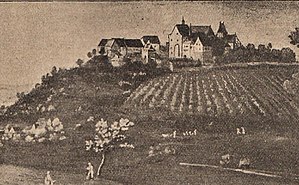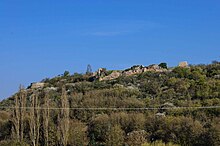Neu-Bolanden Castle
| Neu-Bolanden Castle | ||
|---|---|---|
|
Neubolanden Castle 1613 |
||
| Alternative name (s): | Neubolanden | |
| Creation time : | 1200 to 1300 | |
| Castle type : | Höhenburg, spur location | |
| Conservation status: | Wall remains | |
| Standing position : | Count | |
| Place: | Bolanden | |
| Geographical location | 49 ° 38 '21.5 " N , 8 ° 0' 49.6" E | |
| Height: | 260 m above sea level NHN | |
|
|
||
The castle New Bolanden even Neubolanden , is the ruin of a Spur castle and now a cultural monument. It is located at 260 m on the 276 meter high "Schlossberg" immediately east of the local community Bolanden in the Donnersbergkreis in Rhineland-Palatinate .
history
The castle was built in the 13th century by the Reichsministeriale von Bolanden and was first mentioned from 1258 to 1262. In the 14th century there were disputes over shares in the castle due to partitions. In the middle of the 14th century, Neu-Bolanden Kurpfalz became a fief . It later came into the possession of the Counts of Nassau-Weilburg and was expanded at the beginning of the 15th century. Neu-Bolanden Castle belonged to the Electoral Palatinate secondary school Pfalz-Simmern from 1475 to 1598 and then reverted to the Electoral Palatinate. It served three ducal widows of the Palatinate-Simmern family as a retirement home: from 1480 to 1486 Margarete, daughter of Arnold von Egmond , Duke of Geldern , and widow of Duke Friedrich I ; from 1515 to 1521 of Johanna, daughter of Count Johann III. of Saarbrücken and widow of Duke Johann I ; from 1598 to 1621 of Anna Margaretha, daughter of Count Palatine Georg Johanns I von Pfalz-Veldenz and widow of Duke Reichard . The author of medical works and later city physician of Frankfurt am Main, Arnold Weickard, worked as Anna Margaretha's personal physician at Neu-Bolanden Castle. During the Peasants' War in 1525 the castle was plundered and then burned down. During the reconstruction, the ruin was transformed into a homely castle and served as an administrative and widow's seat. After a Spanish occupation (1620–1625) during the Thirty Years' War , the castle was destroyed by the French in 1689 during the War of the Palatinate Succession and demolished around 1822, with the exception of what is still preserved today.
investment
Only a few remains of the wall are left of the rectangular complex in the spur. Large areas of the castle were demolished in the 19th century. A picture from the 17th century gives an impression of the castle. You can still see the remains of the neck ditch .
literature
- Jürgen Keddigkeit : New Bolanden . In: Jürgen Keddigkeit, Ulrich Burkhart, Rolf Übel (eds.): Palatinate Castle Lexicon. Volume 3 . Kaiserslautern 2005, ISBN 3-927754-51-X , pp. 674-683.
- Gerald FW Müller: Secessit clarissimi viri ... primogenitus - fragment of a grave inscription in the monastery church of Hane . In: Donnersberg-Jahrbuch 2015 - yearbook for the land around the Donnersberg year 38 . Kirchheimbolanden 2014, ISBN 978-3-926306-71-5 , pp. 86-89
Web links
- Entry on new residents in the scientific database " EBIDAT " of the European Castle Institute
Individual evidence
- ↑ Landesvermessungsamt Rheinland-Pfalz: Der Donnersberg und Umgebung , Topographische Karte 1: 25000, 4th edition 1998, ISBN 3-89637-278-5



